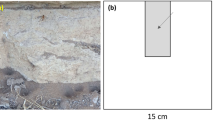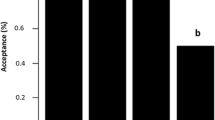Summary
Field and laboratory studies on a colony ofMyrmoteras toro collected in Central Sulawesi and aM. barbouri colony from Singapore have provided the first ecological and behavioral information on this enigmatic formicine genus. Both species capture prey singly by the trap-jaw method, much as do many dacetine and odontomachine ants. Before striking the ants open their jaws 280°, the greatest degree yet recorded in the ants. Also, the nest area is defended from encroachment by other invertebrates by slapping intruders repeatedly with the mandibles.
M. toro workers catch a variety of small, soft-bodied arthropods.M. barbouri preys largely or entirely on springtails. I hypothesize that the trigger hairs characteristic ofM. barbouri and other species of the subgenusMyrmoteras could represent an adaptation to collembolan prey.
Recruitment to food (sugar baits) and during emigrations appears to be absent.
Zusammenfassung
Freiland- und Laboratoriumsuntersuchungen einer Kolonie vonMyrmoteras toro, die im Central Sulawesi gesammelt wurde, und einerM. barbouri Kolonie von Singapore, lieferten die ersten ökologischen und verhaltensbiologischen Informationen über diese wenig bekannte Gattung der Unterfamilie Formicinae. Die Arbeiter jagen einzeln und fangen mit ihren langen Schnapp-Kiefern kleine weiche Evertebraten, ähnlich wie es von Arten der Dacetini und Odontomachini bekannt ist. Bevor die Jägerinnen zuschnappen öffnen sie Kiefer um 280°. Das ist der grösste Mandibel-Offnungswinkel, der bisher von Ameisen bekannt ist. Bei der Nestverteidigung werden Eindringlinge häufig mit den Mandibeln gestossen.
M. toro jagt kleine, weiche Arthropoden, währendM. barbouri nahezu ausschliesslich Springschänze fängt. Ich nehme an, dass die Trigger-Haare, die typisch fürM. barbouri und andere Arten der UntergattungMyrmoteras sind, eine spezielle Anpassung für das Collembolenjagen sind. Rekrutierung zu Futter und Nestplätzen scheint nicht vorzukommen.
Similar content being viewed by others
References
Cole A.C., 1949. —Notes on Gesomyrmex (Hymenoptera: Formicidae).Entomological News, 60, 181.
Creighton T., 1930. — A review of the genusMyrmoteras (Hymenoptera: Formicidae).J. N. Y. Entomol. Soc., 38, 177–191.
Fagen R.M., Goldman R.N., 1977. — Behavioral catalogue analysis methods.Anim. Behav., 25, 261–274.
Forel A., 1893. — Note préventive sur un nouveau genre et une nouvelle espèce de Formicide.Ann. Soc. Entomol. Belg. 37, 607–608.
Moffett M.W., 1985. — Revision of the genusMyrmoteras (Hymenoptera: Formicidae).Bull. Mus. Comp. Zool. Harv., 151, 1–53.
Wheeler W.M., 1910. —Ants. Their structure, development, and behavior. Columbia University Press, Columbia.
Wheeler W.M., 1922. — Observations onGigantiops destructor Fabricius and other leaping ants.Biol. Bull., 42, 185–201.
Wheeler W.M., 1930. —A second note onGesomyrmex.Psyche, 37, 35–40.
Wilson E.O., 1984. —Biophilia. Harvard University Press, Cambridge (Mass.).
Author information
Authors and Affiliations
Rights and permissions
About this article
Cite this article
Moffett, M.W. Trap-jaw predation and other observations on two species ofMyrmoteras (Hymenoptera: Formicidae). Ins. Soc 33, 85–99 (1986). https://doi.org/10.1007/BF02224037
Received:
Accepted:
Issue Date:
DOI: https://doi.org/10.1007/BF02224037




